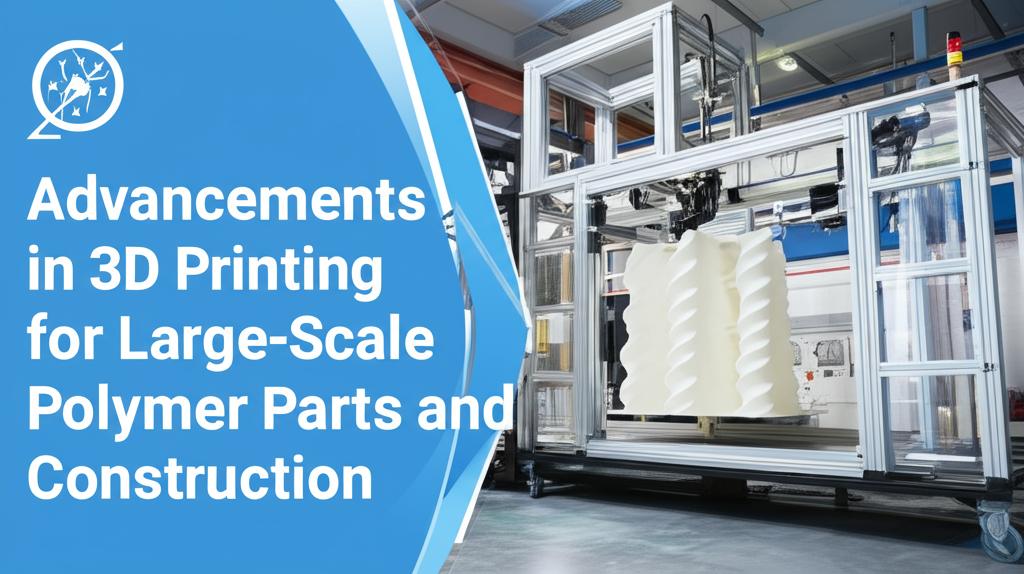Additive manufacturing (AM), or 3D printing, is rapidly evolving, significantly impacting how large-scale polymer parts and construction projects are approached. Once primarily a tool for small, intricate prototypes, AM is now meeting the demands of heavy industries, including aerospace, automotive, marine, construction, and even theme parks, which require large, customized, and lightweight components.
Key Advancements and Trends:- Material Innovation: The development of advanced materials is a primary driver. High-performance polymers, composites, and even metals are expanding the possibilities. For large polymer parts, thermoplastics like PEKK (Polyetherketoneketone) and ULTEM™ 9085 are gaining traction due to their strength, durability, and high-temperature resistance. Research is also focusing on sustainable materials, including recycled plastics, plant-based polymers, and biodegradable options. In construction, specialized mortars and concretes are being developed for 3D printing, with some printers now able to accommodate concrete for greater durability.
- Speed and Efficiency: Innovations in print head technology, multi-material printing capabilities, and automated post-processing are drastically reducing production times compared to traditional methods. Technologies like Continuous Liquid Interface Production (CLIP) are enabling faster production by curing resin continuously rather than layer by layer. For large-scale projects, this means quicker turnaround from design to a finished product. Large-format additive manufacturing (LFAM) is increasingly utilizing thermoplastic materials for this reason.
- Enhanced Multi-Material Printing: The ability to print with multiple materials in a single process is a significant breakthrough. This allows for the creation of complex objects with varying properties, such as rigid structures combined with flexible elements, or parts with different thermal or conductivity characteristics. This is particularly beneficial in aerospace and consumer electronics. Dual material systems are being developed for large-scale AM systems like the Big Area Additive Manufacturing (BAAM), enabling structures with, for example, stiff exteriors and foam interiors.
- Automation and Robotics Integration: Integrating robotics with 3D printing is improving scalability and efficiency. Robotic arms are commonly used in construction 3D printing to extrude materials like concrete, guided by digital blueprints for precision. Automated post-processing and AI-driven real-time monitoring during printing are also becoming more common, minimizing errors and material consumption.
- AI-Driven Design and Optimization: Artificial intelligence is playing a crucial role in optimizing designs for additive manufacturing (DfAM). AI algorithms can generate lightweight, high-performance components and optimize print paths, monitor quality in real-time, and even predict potential failures. This leads to more efficient material use and better end-product performance.
- Sustainability: 3D printing inherently promotes sustainability by reducing material waste through precise material application, unlike subtractive traditional methods. The growing use of recyclable and bio-based materials further enhances its eco-friendly credentials. In construction, faster build times also mean reduced emissions and noise pollution on site.
- Large-Format Printers: The development of printers capable of producing massive components is breaking down previous size barriers. This is enabling applications like printing entire building walls, large molds and dies, and components for wind turbines or marine vessels. Companies like Massivit and Impossible Objects are pushing the boundaries of large-scale printing speeds and capabilities with technologies like Composite-Based Additive Manufacturing (CBAM).
- Aerospace and Automotive: Lightweighting components without compromising strength is crucial. 3D printing allows for complex geometries and rapid prototyping of large parts like fairing panels, interior components, and engine parts.
- Marine: From hull components to complex propulsion systems, large-format 3D printing is enabling innovation in the marine industry.
- Construction: 3D printing is being used to create affordable and sustainable housing, with some printers capable of producing entire structures. Benefits include significantly reduced construction time (houses built in under 24 hours in some cases), lower labor costs, and greater design flexibility for complex architectural elements. Dubai's "3D Printing Strategy," aiming for 25% of new buildings to be 3D printed by 2030, highlights the growing commitment to this technology.
- Industrial Tooling: Large-scale 3D printing is used to produce molds, dies, and other manufacturing aids more quickly and cost-effectively than traditional methods.
Despite rapid advancements, challenges remain. These include limitations in material selection for specific applications, ensuring consistent interlayer bonding for structural integrity, balancing production speed with surface finish quality, and the need for further development in regulations and standards, especially in construction. Post-processing of large parts can also be a bottleneck.
However, the trajectory is clear. By 2025 and beyond, large-format 3D printing is expected to see more mainstream adoption. Continued improvements in speed, cost-effectiveness, material diversity, and the integration of AI and automation will drive this growth. The industry is moving beyond prototyping towards full-scale industrialization and mass production of end-use parts. Collaborative ecosystems and the potential for decentralized, on-demand manufacturing closer to the point of use are also shaping the future, promising to reshape supply chains and unlock new possibilities across numerous sectors.

